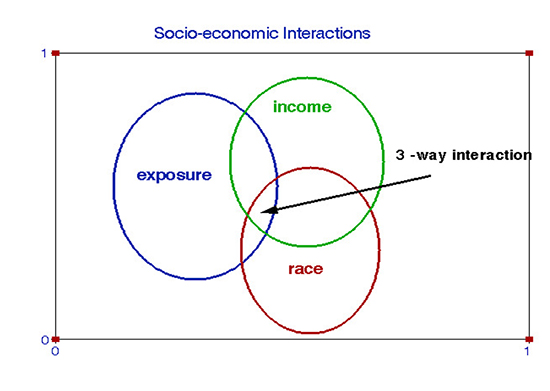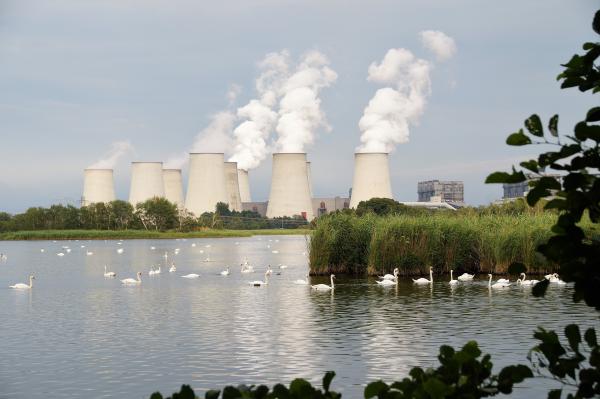The EPA defines environmental injustice as a
“disproportionate share of negative consequences resulting from industrial, municipal, or commercial operations.”
Environmental differences have been a formal concern with the advent of the Clean Air Act, mainly regarding the sites of toxic waste facilities, refineries, chemical plants, etc. This new study used 14 categories of emissions, including electric power, agriculture, manufacturing, road dust, domestic, and construction- almost everything we consume or do. The study converted emission estimates to ambient PM2.5 exposures for 5 Census-defined racial or ethnic groups. For example, contributions of tailpipe exhaust, road dust, and fast-food cooking fumes could be combined to estimate the total environmental impact of a road trip.
Based on geographic variability, the study concluded that PM2.5 exposures for people of color exceed those for whites by 30%: 7.9 vs. 5.9 μg/m3 (both well within the national standard of 12 μg/m3). But exposure per se is not a “consequence,” and any implied links to subsequent adverse health effects remain to be shown.
Problematic Study Design
PM2.5 is a mixture of various types of particles with differing toxicities, depending on the source. They range from potentially hazardous ultrafine carbon particles from incomplete combustion (such as diesel-fueled engines) to much larger but inert particles of terrestrial origin (such as construction or mining). This study makes no distinction for these disparities. More importantly, they did not consider PM2.5 found indoors, where we spend ~85% of our time. Sources of indoor air pollution include tobacco smoke, which can raise indoor PM2.5 levels by as much as 20 μg/m3, along with pet dander, household dust, air fresheners, combustion products from candles, cooking, or fireplaces. There is only sparse information on how indoor exposures might differ by race; black households are half as likely as whites to have air conditioning that can reduce the penetration of outdoor air pollution. Given today’s clean outdoor environment throughout the nation, we need to focus on our immediate indoor environments.
What Are Some Remedies to Environmental Injustices?
In comparison to the copious literature describing the problem, I found few remedies for PM2.5. Shutting down or controlling a source of hazardous emissions is straightforward - the Clean Air Act requires that “Best Available Control Technology” be used to limit emissions. However, PM2.5 is a regional pollutant, and abatement involves many sources over a wide area. As an example, traffic-related air pollutants were far more affected by COVID-19 lockdowns than PM2.5 levels. [1] Selective reduction of PM2.5 by racial characterization is not an option.
The real problem is inequitable poverty, not skin color or ethnicity. The Venn diagram illustrates race-income interactions where each circle contains a range of values. “Exposure” reflects both indoor and outdoor environments. The intersection of exposure and income reflects that wealthier people can afford air pollution  mitigation like air conditioning or living in a high-rise building or near a park; the less affluent may have older and higher emitting cars or homes with increased penetration of outdoor air. The intersection of exposure and race reflects situations where race affects exposure through residence, commuting, or occupation. The intersection of race and income is well-known.
mitigation like air conditioning or living in a high-rise building or near a park; the less affluent may have older and higher emitting cars or homes with increased penetration of outdoor air. The intersection of exposure and race reflects situations where race affects exposure through residence, commuting, or occupation. The intersection of race and income is well-known.
Each circle would stand alone in a perfect world with no intersections; in actuality, each intersection represents an inequity or “injustice.” When all three intersect, race affects exposures, but economic factors preclude countermeasures such as eliminating indoor sources of air pollution or reducing infiltration of polluted outdoor air by modern ventilation systems.
Inequities will always exist in a free society, whether from lack of opportunity, societal constraints, or just bad luck. Ambient air quality varies according to the needs of that society, as is the case with traffic exposures, for example. A recent cohort study of air pollution mortality risks stratified by race showed that blacks had higher traffic exposure but not to conventional air pollutants, including PM2.5. Mortality risks per unit of air pollution were 40% lower for blacks. Indoor air quality was not considered in this or any other air pollution mortality study; true exposures and thus risks remain unknown for all races and ethnic groups, as do any resulting inequities.
Conclusions
The current study reported by the NY Times was meticulously done but irrelevant because of its problematic premise: that uneven distributions of a regional pollutant of unspecified toxicity (PM2.5), created by a large number of unidentified sources, could constitute an environmental injustice to populations of color. Increased exposure per se does not result in actual injustice, which can only occur if significant differences in adverse health effects are identified. Beyond this conceptual problem lies the neglect of exposures from indoor air pollution sources that are also likely to vary by race or ethnicity.
[1] Even electric vehicles produce road dust and particles from brake and tire wear.



